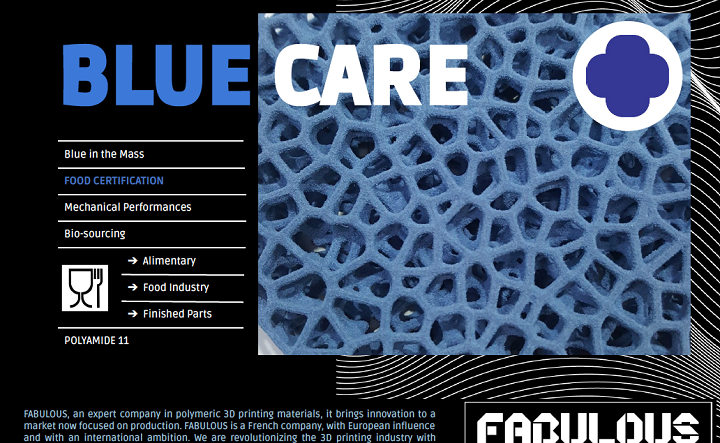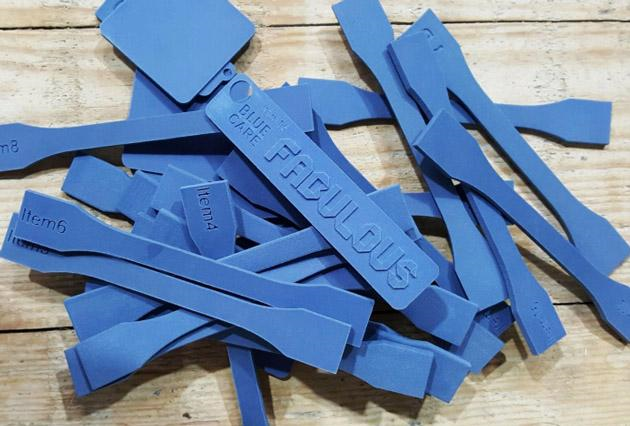While we often talk about how PLA, or polylactic acid, is a pretty eco-friendly 3D printing filament, as it’s made from a variety of different plant products like corn and potatoes and therefore biodegradable, this doesn’t actually mean that it’s 100% food-safe. Of course, you can sometimes make 3D printed items, like wineglasses and utensils, safe for contact with food by coating them with materials like silicone, but that kind of defeats the purpose of, “Look, I 3D printed this plate, off of which I’m eating my 3D printed sushi!” As our Executive Editor Joris Peels has pointed out, all filament will eventually need to be food-safe for consumer 3D printing to be commercially viable, which is why several industry companies, such as Royal DSM and Filaments.ca, are working on this as we speak.
Another company that has developed a food-safe material is French design firm and polymeric 3D printing materials expert FABULOUS, which you might remember from its interesting 3D printed Mars habitat idea back in 2015. In its own words, the company is “revolutionizing the 3D printing industry with materials that meet the application needs of end users,” which includes the food industry. As such, FABULOUS is introducing BLUE CARE, a unique new powder 3D printing material that’s food-safe.
BLUE CARE material is, obviously, blue, based out of polyamide 11 (PA11) Nylon material, and developed for MJF, IRS, and SLS powder 3D fusion 3D printing. FABULOUS says that its innovative powder has been certified for Food Contact Application, following the “Commission Regulation (EU) No 10/2011 of 14 January 2011 on plastic materials and articles intended to come into contact with food.”
“Additive Manufacturing is a production technology growing in every market, changing from prototyping applications to production,” the company wrote. “The Food Industry (and others) market follows this trend and BLUE CARE comes to answer the some of its needs.”
Some of these needs, and applications, include blue plastic safety parts that, because of their visibility, can be used in various industrial areas, like the food industry, that use real-time production lines. FABULOUS explained that the color helps identify and prevent “foreign bodies or fragments of plastics in food by visual or optical blue detection.”
“BLUE CARE parts have different colours depending on the post processing, directly after printing the colour presents RAL 5023 (Distant Blue), after chemical smoothing it’s possible to achieve the RAL 5005 (Safety Blue),” FABULOUS wrote.
Additionally, BLUE CARE will likely be a good product for 3D printing final machinery parts that are certified for food contact. Plastic parts that come into direct contact with food obviously needs to meet pretty strict material guidelines, in order to make absolutely certain that it’s not harmful. FABULOUS explains that, in addition to the aforementioned Commission Regulation (EU) No 10/2011, BLUE CARE has other important certifications and meets the requirements for international regulations in terms of parts that come in contact with food:
- EN 1186-1 and EN 1186-3: Materials and articles in contact with foodstuffs. Plastics test methods for overall migration into acidic foods and aqueous food simulants by total immersion.
- EN 1186-15:2002: Materials and articles in contact with foodstuffs. Plastics alternative test methods for migration into fatty food simulants by rapid extraction into isooctane and/or 95 % ethanol.
FABULOUS says that BLUE CARE has been tested using the Prodways P1000 SLS 3D printer, and that the material is compatible with all powder bed fusion systems, with a recommended refresh rate of 50% and parameters that are similar to what’s used when 3D printing PA11 natural. Additionally, the company says that mold, spores, and food and detergent residue are pretty easy to spot on parts 3D printed out of its BLUE CARE powder, which makes cleaning easier as well.
You can purchase a 1 kg container of food-safe BLUE CARE 3D printing powder for €65.
(Source/Images: FABULOUS)
Subscribe to Our Email Newsletter
Stay up-to-date on all the latest news from the 3D printing industry and receive information and offers from third party vendors.
You May Also Like
World’s Largest Polymer 3D Printer Unveiled by UMaine: Houses, Tools, Boats to Come
The University of Maine has once again broken its own record by unveiling the largest polymer 3D printer in the world. Surpassing its 2019 achievement, the new Factory of the...
Changing the Landscape: 1Print Co-Founder Adam Friedman on His Unique Approach to 3D Printed Construction
Additive construction (AC) is much more versatile than it seems, at first: as natural as it is to focus on the exciting prospect of automated home construction, there’s far more...
Gorilla Sports GE’s First 3D Printed Titanium Cast
How do you help a gorilla with a broken arm? Sounds like the start of a bad joke a zookeeper might tell, but it’s an actual dilemma recently faced by...
3D Printing Webinar and Event Roundup: April 21, 2024
It’s another busy week of webinars and events, starting with Hannover Messe in Germany and continuing with Metalcasting Congress, Chinaplas, TechBlick’s Innovation Festival, and more. Stratasys continues its advanced training...
































